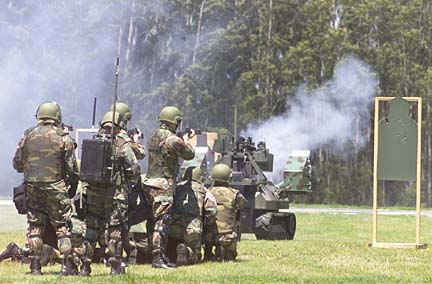
DENNIS ODA / DODA@STARBULLETIN.COM
Marine Forces Pacific Experimental Center at Camp Smith rolled out a model of the Gladiator, a remotely controlled vehicle equipped with non-lethal weapons that is designed to help Marines disperse crowds, in a demonstration last week.
New technology to disperse
crowds uses non-lethal weapons
and remote controls
During "Operation Real Freedom," Sgt. William Meyers and his rifle squad of more than a dozen Kaneohe Marines were confronted on the outskirts of the desert town of Intoit by a group of more than 200 belligerent activists still loyal to their overthrown government.
Armed only with rocks and slingshots, the crowd refused to disperse, preventing aid from being delivered. Meyers had been warned that there were people in the town armed with AK-47 rifles and rocket-propelled grenades. Meyers had strict orders concerning when he could fire upon civilians or use chemical agents.
However, in this demonstration, Meyers' rifle squad had a new weapon in its arsenal: the "Gladiator." The 1,600-pound, tracked unmanned vehicle is equipped with non-lethal weapons designed to help the Marines disperse crowds without having to resort to gunfire.
Last week, the Marine Forces Pacific Experimental Center at Camp Smith rolled out a model of the Gladiator, which has smoke grenades, rubber bullets, tear gas and stingballs. Military planners say it is still only in the "conceptual" stage of development.
Ray Grundy, spokesman for the Marine Corps' non-lethal weapons program in Virginia, said that in today's world where the military must abide by strict rules of engagement "the only thing that stands between our forces and a large crowd is three-quarter inch of non-ballistic plastic, a riot shield."
DENNIS ODA / DODA@STARBULLETIN.COM
Sgt. Arnold Den Beste, a Kaneohe military policeman, holds the Gladiator's remote control, which is equipped with a small color screen and joysticks to control the vehicle and the weapons systems.
In places like Somalia, Kosovo, Bosnia, Afghanistan and now Iraq, Grundy said, Marines and soldiers don't have the capability to switch quickly from being on the defensive to taking control of a potential riot.
"Many times they have to stand toe-to-toe with a rioting control," Grundy said.
What Grundy has been working on for the past three years is an unmanned vehicle armed with various riot-control equipment to give Marines and soldiers an edge in crowd control. The idea is to send the Gladiator, controlling it from a safe distance, to try to break up a crowd.
He and other members of the Marine Corps' Combat Development Command from Quantico, Va., were at Camp Smith to demonstrate the Gladiator.
The Gladiator also can be armed with an M-240G machine gun or 9mm Uzi if needed, he said.
Grundy hopes to be able to get anywhere from $1.8 million to $2.5 million next year to develop four prototype models, each armed with a different payload. He eventually hopes the Marine Corps will receive funding by 2007 to field 192 Gladiators.
"It would be a significant achievement," Grundy said. "We will be the first military service to field this kind of capability for crowd control."
The current Gladiator was designed from scratch and cost about $250,000. However, by the time all the testing and evaluations have been completed four years from now, the Marine Corps estimates that the cost per vehicle will drop to $150,000.
At last week's "Operation Real Freedom" demonstration at Camp Smith's helicopter pad, Sgt. Arnold Den Beste, a Kaneohe military policeman, was chosen to operate the Gladiator. Den Beste, 34, had only a day and a half to familiarize himself with the handheld controller, which is equipped with a 5-by-7-inch color screen, two joysticks -- one directs the vehicle while the other controls the various weapons systems -- and an array of buttons.
The radio, antenna, computer, batteries and GPS devices, weighing about 20 pounds, fits easily into his backpack.
Den Beste positioned himself about 10 feet behind the Gladiator, using one of four television cameras to guide the vehicle to its target. As the Gladiator and the squad of Marines advanced on the crowd, which was simulated by silhouette targets, Den Beste fired off volleys of smoke grenades to try to disperse the demonstrators. The closer the Marines and the Gladiator got to the crowd, the more intense the dispersal of non-lethal weapons became, climaxing with a burst of machine-gun fire.
"It only took me five minutes to learn how to operate the control panel," Den Beste said. "It's like a video game with this joystick to drive it, and another one to control the weapons."
"Just by placing the cross hairs on the target, I know I can hit anything," said Den Beste, referring to the controls for the stingball gun and the M-240G machine gun.
Both weapons are mounted on the top of the vehicle. The stingball gun uses compressed air to fire .60-caliber paint-ball-style pellets. The Gladiator also is capable of tossing smoke grenades, riot control tear gas pellets and stingball grenades from the 30 tubes mounted on either side of the tracked vehicle.
Grundy said the U.S. military is not allowed to use any type of chemical agents, including tear gas, with the Gladiator, but he believes this capability would be a great asset to civilian law-enforcement agencies.
The fully armored vehicle is equipped with four night and day cameras and thermal imaging capabilities, which allow the operator to identify and engage threats.
Grundy said he wishes he had a tool like the Gladiator in 1993 when he was a battalion weapons officer with the 24th Marine Expeditionary Force in Somalia.
"It was difficult," Grundy recalled. "We had to man checkpoints. There were large crowds we had to move and we had no non-lethal weapons to be dominant ... We were not equipped to deal with restrictive rules of engagement."


